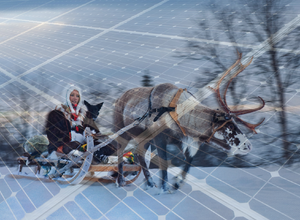
This study assesses the viability of photovoltaic (PV) technology in northern latitudes as a part of energy supply system for remote nomadic camps of indigenous communities involved in reindeer husbandry. Two boundary locations were analyzed: southern Yakutia, Russia, 56°41′N; and the northernmost area in Norway, Finnmark, 68°51′N. Sixteen scenarios were simulated based on energy consumption, light sources and electric load schedules. The results show that PV-based systems are beneficial under a variety of economic conditions and fuel prices when compared to systems solely fuel-based. Incandescent lights, which are currently common for such settlements, should be replaced with LED lighting to enable easier PV system portability by reindeer sled. For areas with significant numbers of minimal solar flux days partial load scheduling is necessary for economically viable systems. The simulations showed that the specific weight of the system (excluding support structure) measured as the system total weight to the number of camp residents ratio can be reduced by a factor of two for optimized loads to 5.8 kg/person for a low energy-intensive camps and 11.0 kg/person for a high energy intensive camps.
Highlights[edit | edit source]
- Simulated viability of PV system replacing gasoline for north reindeer herding.
- PV system is beneficial to serve camp electric needs compared to fuel-based one.
- Incandescent lighting should be replaced with LEDs for portable PV system.
- Winter daily solar flux fluctuation plays significant role in the system size.
- Partial load decrease during winter strings of “dark-days” reduces PV system capacity.





